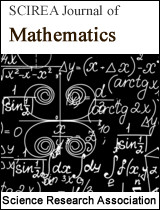Bifurcations of a discrete-time Phytoplankton-Zooplankton model
DOI: 10.54647/mathematics110427 97 Downloads 173066 Views
Author(s)
Abstract
This work mainly investigates the bifurcation problems and topological classifications of a discrete phytoplankton-zooplankton model, whose continuous version was proposed by Truscott and Brindley in 1994. The model is derived by using the semi-discretization technique. Within this study, trivial and semi-trivial fixed points are identified, as well as an interior fixed point that emerges based on specific parametric conditions. Subsequently, an exploration of their topological classifications is undertaken, employing linear stability theory in the vicinity of the trivial, semi-trivial, and interior fixed points. Leveraging the center manifold theorem and bifurcation theory, it is feasible to derive conditions under which the flip and Neimark-Sacker bifurcations are expected to transpire. To validate these findings and draw conclusions, numerical simulations are conducted which produce proof of a Neimark-Sacker bifurcation. Through these comprehensive analyses and simulations, the main aim of this research is to effectively augment the understanding of the dynamics of the model and affirm the validity of our results.
Keywords
Phytoplankton-zooplankton model, semi-discretization, flip bifurcation, Neimark-Sacker bifurcation.
Cite this paper
Vimbiso Shiri, Xianyi Li,
Bifurcations of a discrete-time Phytoplankton-Zooplankton model
, SCIREA Journal of Mathematics.
Volume 8, Issue 5, October 2023 | PP. 139-174.
10.54647/mathematics110427
References
| [ 1 ] | Truscott, J.E., Brindley, J. Ocean plankton populations as excitable media. Bltn Mathcal Biology 56, 981–998 (1994). https://doi.org/10.1007/BF02458277 |
| [ 2 ] | Steele, J. H., & Henderson, E. W. (1981). A Simple Plankton Model. The American Naturalist, 117(5), 676–691. http://www.jstor.org/stable/2460753 |
| [ 3 ] | Wyatt, T., Horwood, J. Model which Generates Red Tides. Nature 244, 238–240 (1973). https://doi.org/10.1038/244238a0 |
| [ 4 ] | Roy, S., Bhattacharya, S., Das, P. and Chattopadhyay, J., 2007. Interaction among non-toxic phytoplankton, toxic phytoplankton and zooplankton: inferences from field observations. Journal of Biological physics, 33(1), pp.1-17. |
| [ 5 ] | Chakraborty, S., Bhattacharya, S., Feudel, U. and Chattopadhyay, J., 2012. The role of avoidance by zooplankton for survival and dominance of toxic phytoplankton. Ecological complexity, 11, pp.144-153. |
| [ 6 ] | Ebenhöh, Wolfgang. (1980). A Model of the Dynamics of Plankton Patchiness. Modeling, Identification and Control. 1. 10.4173/mic.1980.2.2. |
| [ 7 ] | Hutchinson, G.E., 1961. The paradox of the plankton. The American Naturalist, 95(882), pp.137-145. |
| [ 8 ] | Uye, S. 1986. Impact of copepod grazing on the red tide flagellate chattonella antique. Mar. Bio.92, 35. |
| [ 9 ] | Chakraborty, Kunal & Das, Kunal. (2014). Modelling and analysis of two-zooplankton one-phytoplankton system in presence of toxicity. Applied Mathematical Modelling. 39. 10.1016/j.apm.2014.08.004. |
| [ 10 ] | Geoffrey T. Evans & John S. Parslow (1985) A Model of Annual Plankton Cycles, Biological Oceanography, 3:3, 327-347, DOI: 10.1080/01965581.1985.10749478 |
| [ 11 ] | Khan, A.Q., Javaid, M.B. Discrete-time phytoplankton–zooplankton model with bifurcations and chaos. Adv Differ Equ 2021, 415 (2021). https://doi.org/10.1186/s13662-021-03523-5 |
| [ 12 ] | Grattan, L.M. , Holobaugh, S. and Glenn Morris, J.G. Jr . , 2016. Harmful algal blooms and public health. Harmful Algae , 57( B), 2 –8. DOI:10.1016/j.hal.2016.05.003 |
| [ 13 ] | Fasham, M.J., Ducklow, H.W., & Mckelvie, S.M. (1990). A nitrogen-based model of plankton dynamics in the oceanic mixed layer. Journal of Marine Research, 48, 591-639. |
| [ 14 ] | Rose, K.A., Swartzman, G.L., Kindig, A.C. and Taub, F.B., 1988. Stepwise iterative calibration of a multi-species phytoplankton-zooplankton simulation model using laboratory data. Ecological Modelling, 42(1), pp.1-32. |
| [ 15 ] | Rosenzweig, M L. “Paradox of enrichment: destabilization of exploitation ecosystems in ecological time.” Science (New York, N.Y.) vol. 171,3969 (1971): 385-7. doi:10.1126/science.171.3969.385 |
| [ 16 ] | Vanselow, A., Halekotte, L., Pal, P., Wieczorek, S. and Feudel, U., 2022. Rate-induced tipping can trigger plankton blooms. arXiv preprint arXiv:2212.01244. |
| [ 17 ] | W. Li and X. Y. Li, Neimark-Sacker bifurcation of a semi-discrete hematopoiesis model, J. Appl. Anal. Comput., 8 (2018) 1679-1693. |
| [ 18 ] | C. Wang and X. Y. Li, Stability and Neimark-Sacker bifurcation of a semi-discrete population model, J. Appl. Anal. Comput., 4 (2014) 419-435. |
| [ 19 ] | Xianyi Li, Xingming Shao. Flip bifurcation and Neimark-Sacker bifurcation in a discrete predator-prey model with Michaelis-Menten functional response[J]. Electronic Research Archive, 2023, 31(1): 37-57. doi: 10.3934/era.2023003 |
| [ 20 ] | Khan, A., Ma, J., Xiao, D.: Global dynamics and bifurcation analysis of a host–parasitoid model with strong Allee effect[J]. 2017, 11(1): 121146. doi:10.1080/17513758.2016.1254287 |
| [ 21 ] | Liu, W., Cai, D.: Bifurcation, chaos analysis and control in a discrete-time predator–prey system. Adv. Differ. Equ. 2019(1), 11 (2019) |
| [ 22 ] | Zhuo Ba, Xianyi Li. Period-doubling bifurcation and Neimark-Sacker bifurcation of a discrete predator-prey model with Allee effect and cannibalism[J]. Electronic Research Archive, 2023, 31(3): 1405-1438. doi: 10.3934/era.2023072 |
| [ 23 ] | Shah, S.M., & Wiener, J. (1983). ADVANCED DIFFERENTIAL EQUATIONS WITH PIECEWISE CONSTANT ARGUMENT DEVIATIONS. International Journal of Mathematics and Mathematical Sciences, 6, 671-703. |

